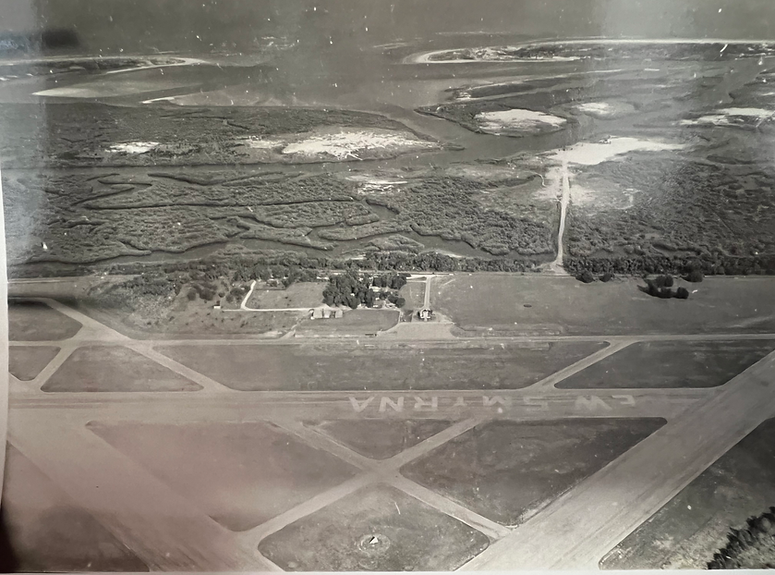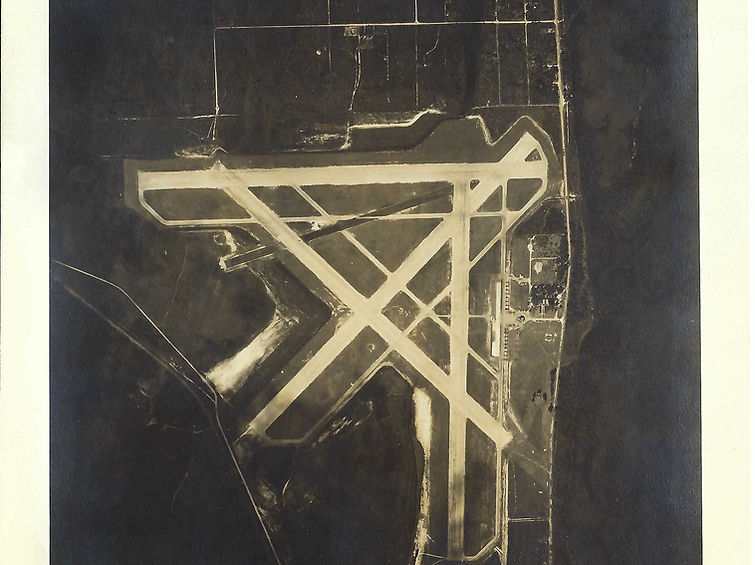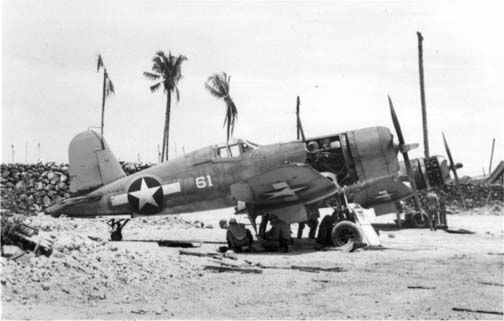NSB AIRPORT HISTORY
Florida's East Coast Defense System

Our Story
New Smyrna Beach has been part of aviation since the 1930's having aircraft land on its current site when it doubled as a 9-hole golf course. In addition to this, there was a site on the beach for early aviators to land and enjoy. Once the U.S. began preparing for World War II in the late 1930s, this land was acquired by the U.S. War Department to pave runways for both a training base and the first line of defense against the Axis powers. This made NSB a vital city in the protection of the United States. During this time, the identifier for our airport was "NOLF" as it was the Naval Outlying Field for the Daytona Naval Air Station. It was later changed to "EVB" as it was an East Volusia Base.

World War II introduced Florida to soldiers from all over the United States. The year-round warm weather made Florida an ideal training area for enlistees, and the War Department built many installations in Florida and other southern states.
America’s military expansion began in the late 1930s as Germany’s rearmament and Japan’s aggression in China caused increasing concern among U.S. leaders. In 1940 the Navy commissioned the Banana River Naval Air Station. It became the nucleus of the Cape Canaveral aerospace development after WWII. Personnel at the station had the duty of patrolling the Atlantic Coast for possible German submarines. The Gulf Stream was used for transportation of vital fuels from Texas to New Jersey. This made those ships a target. The cape’s deep water close to shore allows for a submarine to get a better view of possible shoreline targets. German submarines notoriously targeted American ships as well as others in the channel. Witnesses could see the ships burning along the coast as near as one could see a shrimp boat fishing along the coast today. Seven freighter or tankers were sunk off the coast of Cape Canaveral during the WWII era.

Another close by base was Naval Air Station Daytona. Daytona Beach city commissioners convinced Jacksonville naval personnel that a training facility would be a good idea for Daytona in hopes of boosting the economy after a national economic depression had occurred years earlier. Soon after in May 1942, the Daytona Beach airport transitioned into a training facility and was named Daytona Beach Naval Air Station.
Field trainers that were recruited from those that served in the Battle of Midway and the Battle of the Coral Sea. Both required the service of dive bomber pilots. A few to name were Lt. William E. Hall who received the Medal of Honor at the Battle of the Coral Sea and Commander Maxwell F. Leslie a hero at the Battle of Midway who took charge of the training facility.
Dive bomber pilots began training in 1942 along what is now Canaveral National Seashore coastline. Two field facilities were set up in New Smyrna Beach (NSB). A naval auxiliary gunnery field at the NSB airport (NOLF) that included launch catapult training. In 1942 an air-to-sea rescue crash boat facility was situated at the New Smyrna Beach Anglers Club. During this time, the Navy completely remodeled the club to fit its wartime needs. "PT" boats were based at the Anglers Club to tow targets for pilot training as well as to rescue them if they crashed. The pilot and the aircrewmen had to learn to work together to site the target and monitor altitude with the limited technology of the time. Many of the Douglass SBD Dauntless dive bomber planes used for training had already seen battle and were adorned with Japanese Kill flags.

Two training targets were constructed within the now Canaveral National Seashore boundary. One was bombing target “Tokyo,” which was a ring of palmetto log pilings driven into the bottom of the lagoon. The other was a strafing target called “Nagoya,” an airplane fuselage filled with concrete.
In 1944 they went from training 832 dive bombers to training 560 fighter pilots to combat the then new occurrence of kamikazi pilots. Fighter pilots trained in F4F Wildcat planes and eventually F6F Hellcats. WAVES (women accepted for voluntary emergency services) came in to train as intercept directors. Intercept directors guided planes to the target. The Daytona Training Facility was closed down in 1945. Over 195,000 flight hours were logged at the short lived training facility. Both field training sites Nagoya and Tokyo were abandoned at the end of WWII. Remnants of the strafing target, a boulder size chunk of the concrete with attached bits of metal from the fuselage, is a landmark to local residents known as Target Rock. This is located in an area closed to the public on NASA property.
Numerous wildfires resulted from the bombing activity, with one fire in 1940 or 1941 burning the entire length of the future Seashore’s barrier island from New Smyrna Beach to the Cape Canaveral.
By the end of WWII the Soviet Union had emerged as a new enemy. With this came the race to develop new technologies such as jet aircraft, ballistic missiles, and unmanned rockets. The space race emerged. In 1948 the Banana River Naval Air Station was transferred to the Air Force and became a long range missile proving ground (LRPG).

Jack Bolt Field
Our airport was dedicated as Jack Bolt Field; this was in honor of an exceptional New Smyrna resident and war hero from WWII. Our city prides itself on commemorating someone who had a warrior spirit and undying dedication to his country. We honor all those who have fought wars on America's behalf, enshrining themselves into the great hall of war fighters who have answered the call when war becomes a reality.

John F. "Jack" Bolt a Marine fighter pilot was an American Double Ace, having shot down at least five enemy airplanes in both World War II and the Korean War. In the summer of 1941, he joined the Marine Corps Reserve to train as a pilot and to earn money for college. He earned his Wings of Gold and a commission in the Marine Corps in July 1942. After a short tour as an instructor, Bolt went to the South Pacific, and in 1943, was assigned to Marine Fighting Squadron (VMF) 214, nicknamed the “Black Sheep,” led by Major Gregory “Pappy” Boyington. Bolt, who flew 94 missions in an F4U Corsair fighter during the Solomon Islands campaign, was credited with six kills. Commander Boyington was shot down during the campaign and captured by the Japanese, leaving Bolt in Command of VMF-214. After learning to fly jet fighters after World War II, Bolt was assigned to fly with the Air Force during the Korean War. In a three-month period in 1953, flying F-86 Sabre jets, he shot down six Russian-built MIG-15s. He was the only Marine Corps ace of the Korean War, and one of only seven Americans to become an ace in both wars.


During 94 missions in support of Marine ground forces, he worked to improve fighter-bomber tactics. His analysis of damage to Marine aircraft highlighted that pilots were flying through their own bomb fragmentation patterns. He initiated point blank bombing using special delayed action fuses, allowing an aircraft to pull clear before its bomb detonated, which reduced self-inflicted damage to Marine fighters. Bolt instituted the use of phosphorous bombs with proximity fuses that under the proper conditions provided greater coverage than napalm bombs.
In addition to three awards of the Distinguished Flying Cross, Bolt received the Navy Cross “for extraordinary heroism” for his actions on July 11, 1953, “when he led a flight low on fuel, in an attack on four enemy planes and personally downed two of them.” He was inducted into the Commemorative Air Force’s American Combat Airman Hall of Fame in Midland, Texas in 2003.
Colonel Bolt retired from the Marines in 1962. Raised in Sanford, Florida, he resided in New Smyrna Beach over 34 years, where he enjoyed a second career as a lawyer. Asked for the key to his prowess in the air, he once said, “You simply want to shoot down airplanes more than anything else in the world.”
Flying an F4U Corsair fighter during the Solomon Islands campaign in late 1943 to early 1944, Colonel Bolt shot down six Japanese Zero fighters. Piloting an F-86 Sabre Jet while attached to the Air Force’s 39st Fighter Interceptor Squadron in the Korean War in 1953, he downed six Soviet-built MIG’s.
Colonel Bolt was the only Marine Corps Ace of the Korean War, and to this day he is the only Marine Corps Jet Ace. He is one of only seven Americans to become an Ace in both wars and the only naval aviator to hold that distinction.
In addition to three Distinguished Flying Crosses and two USAF Air Medals, Colonel Bolt was awarded the Navy Cross “for extraordinary heroism” for his actions on July 11, 1953, “when he led a flight low on fuel in an attack on four enemy planes and personally downed two of them.”


"Ace of the Black Sheep Squadron"
Resources:
Brady, Tim. “The Daytona Beach International Airport in Uniform.” Embry Riddle Aeronautical University, 2008, commons.erau.edu/cgi/viewcontent.cgi?article=1445&context=jaaer .
Parker, Susan. “Canaveral National Seashore History Resource Study.” IRMA, 2008, irma.nps.gov/DataStore/DownloadFile/458702.
Coles, D. J. (2000). Florida World War II Heritage Trail. Retrieved 2020, from https://dos.myflorida.com/media/32351/worldwariiheritagetrail.pdf


